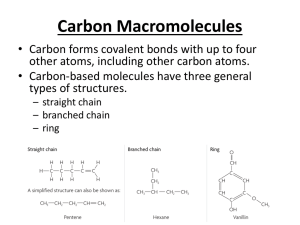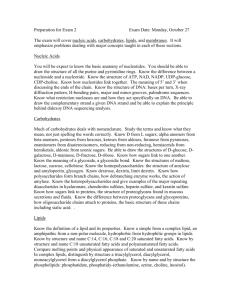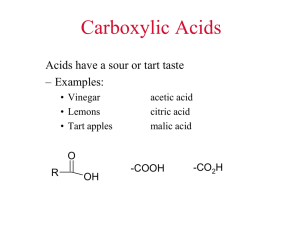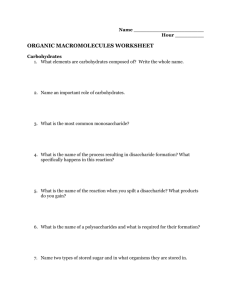Review for Exam II and the 2nd Lab Practical
advertisement
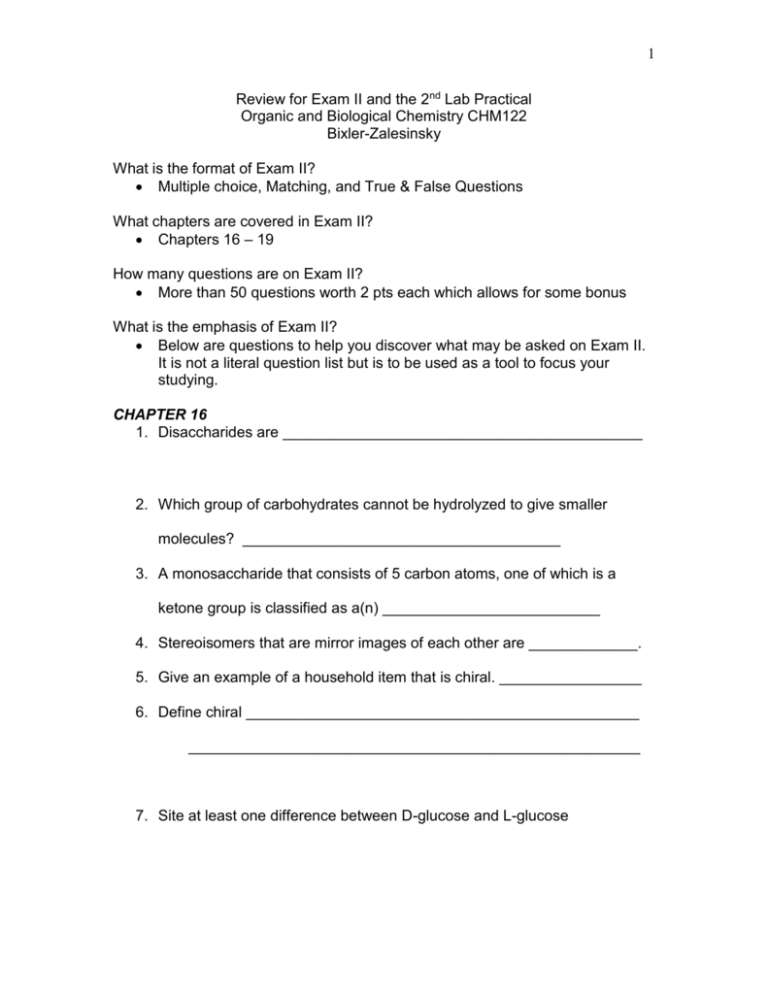
1 Review for Exam II and the 2nd Lab Practical Organic and Biological Chemistry CHM122 Bixler-Zalesinsky What is the format of Exam II? Multiple choice, Matching, and True & False Questions What chapters are covered in Exam II? Chapters 16 – 19 How many questions are on Exam II? More than 50 questions worth 2 pts each which allows for some bonus What is the emphasis of Exam II? Below are questions to help you discover what may be asked on Exam II. It is not a literal question list but is to be used as a tool to focus your studying. CHAPTER 16 1. Disaccharides are ___________________________________________ 2. Which group of carbohydrates cannot be hydrolyzed to give smaller molecules? ______________________________________ 3. A monosaccharide that consists of 5 carbon atoms, one of which is a ketone group is classified as a(n) __________________________ 4. Stereoisomers that are mirror images of each other are _____________. 5. Give an example of a household item that is chiral. _________________ 6. Define chiral _______________________________________________ ______________________________________________________ 7. Site at least one difference between D-glucose and L-glucose 2 8. List three common uses or places to find glucose __________________________________________ __________________________________________ __________________________________________ 9. Give two examples of noncarbohydrate sweeteners _____________________________________________ _____________________________________________ 10. What is galactosemia? ______________________________________ __________________________________________________________ ____________________________________________________________ 11. What is hyperglycemia? _____________________________________ ___________________________________________________________ 12. In the carbon cycle, CO2 and water are converted to glucose and oxygen by ____________________________________ 13. What is glycogen? __________________________________________ _________________________________________________________ 14. What is cellulose? __________________________________________ 15. What dissacharide is made up of glucose and fructose? ____________ CHAPTER 17 16. Give the functional group of a carboxylic acid. ___________________ 17. Name the acid found in white vinegar. _________________________ 18. In water solution, how does dilute acetic acid behave? _____________ 19. What determines the solubility of a carboxylic acid? _______________ __________________________________________________________ 3 20. Write the functional group of an ester. ________________________ 21. How is a carboxylic acid named in the IUPAC system? ______________ 22. Which one is a stronger acid? (Circle one: sulfuric OR carboxylic) acid 23. In common naming of a carboxylic acid, what is the correct Greek letter used for the carbon adjacent to the carboxyl group? ______________ 24. What therapeutic use is made of -hydroxy acids? ________________ __________________________________________________________ 25. What significant side effect is seen with -hydroxy acid use? _________ _________________________________________________________ 26. What kind of intermolecular force occurs between carboxylic acids? ______________________________________________________ 27. What is the common use of monosodium glutamate (hint MSG)? _____________________________________________________ 28. What is the common use of sodium propionate and sodium benzoate? ________________________________________________________ 4 29. What metabolic product of pyruvic acid is formed anaerobically during exercise? _______________________________________________ 30. What is the product of the reaction of an alcohol and a carboxylic acid when reacted together under acidic conditions? _________________ CHAPTER 18 *(remember we did chapter19 then chapter 18, but they are in numeric order on this review to aid you in looking up answers in your text.) 31. List four facts about lipids ________________________________________________ ________________________________________________ ________________________________________________ ________________________________________________ 32. List four physiological functions of lipids. ________________________________________________ ________________________________________________ ________________________________________________ _______________________________________________ 33. A polyunsaturated fatty acid contains more than one ______________. 34. Unsaturated fatty acids have (circle one: lower OR higher) melting points than saturated fatty acids because ______________________________ ___________________________________________________________ 35. A long-chain alcohol and long-chain fatty acid form a(n) _____________ 5 36. A triglyceride that is solid at room temperature is called a(n) __________ 37. Commercially, liquid vegetable oils are converted to solid fats such as margarine by ______________________. 38. A fat or oil becomes rancid when ________________________________. 39. Margarine containing partially hydrogenated soybean oil is solid because ________________________________________________________ ________________________________________________________ 40. Why can a fatty acid act as a soap to remove grease? ______________ ____________________________________________________ 41. Glycerophospholipids can interact both with other lipids and water because they contain both _______________ and _________________ regions. 42. The main lipid components in cellular membranes are ____________________________. 43. Glycosphingolipids are lipids composed of ________________________, ____________________________, and __________________________. 44. The steroid hormone that increases the blood glucose and glycogen levels from fatty acids and amino acids is ___________________________. 45. In the fluid-mosaic model that describes plasma membranes, two layers of __________________________ molecules have their _______________ sections oriented to the inside of the membrane. 6 46. Channel proteins in a cell membrane serve what function? __________________________________________________________ _________________________________________________________ 47. A double cheeseburger with bacon contains 640 kcal and 39 g of fat. Calculate the number of kilocalories from fat. (1 g of fat = 9 kcal; 1 gram of carbohydrates or protein delivers 4 kcal.) 48. Olesterol is a __________________________ (classification of lipid). CHAPTER 19 49. The compound CH3CH2NHCH3 is classified as a (circle one: 10, 20, or 30) 50. In response to allergic reactions or injury to cells, the body increases the production of ____________________________. 51. Physiologically active nitrogen-containing compounds produced by plants are called _________________________. 52. List four alkaloids. ________________________________________________ ________________________________________________ ________________________________________________ ________________________________________________ 53. Amines contain ________________ (element). 7 54. In what kind of amine is the nitrogen bonded to two carbon atoms? ______________________________________________________ 55. What functional group is always found in alkoids such as caffeine, nicotine, and digitalis? __________________________________ 56. Diphenhydramine (Benedryl) contains both ______________ and ____________________ functional groups. 57. What pharmacologic activity do amphetamine, phenylephrine, and methedrine have in common? ____________________________ 58. What pharmacologically active amine is responsible for the signs and symptoms encountered in an allergic reaction? _________________ 59. The prefix nor- in a drug name means that there is _______________ _____________________________________________________________ 60. If the number of carbons is similar, which will have a higher boiling point? (Circle one: amine or hydrocarbon) 61. What kind of pharmacologic activity is found in the amines Procaine and Lidocaine? ______________________ These drugs were developed by modifying the structure of __________________________. 62. What kind of compound is urea? ______________________________ 63. What is the chemical classification of the barbiturate sedatives? ___________________________________________________ 64. Valium is chemically classified as a(n) ________________________. 65. Amines having fewer than ________ carbons are generally water soluble. 8 2nd LAB PRACTICAL REVIEW What is the format of the lab practical? It is a combination of multiple choice, matching, and true & false questions. It also has a component for finding the identity of an unknown. How many questions are on the practical? It contains more than 30 questions worth 1 point each which composes half of this grade. The other half of this grade is composed of the correct identification of an unknown. Is there a time limit for this practical? It is the policy of the Science Department that this practical be limited to no more than 90 minutes. After the practical there will be a short introduction to nucleic acids. How should I study for this practical? Develop a flow chart of tests to use in the identification of the unknown substance. You may use this flow chart in identifying your unknown. Below is a list of questions designed to help focus your studies. It is not a literal question list. You may find it beneficial to study with your lab partner, but remember you cannot work with a lab partner during the practical. Experiment 26—Carbohydrates 1. Most disaccharides give (+ or – ) Benedict’s test, (+ or - ) iodine test, (can or cannot) be hydrolyzed, (do or do not) undergo mutarotation. 2. Maltose is what kind of carbohydrate? _______________________ 3. Which sugar gives a positive Benedict’s test but is negative with iodine and fermentation tests? ______________________________ 4. Which sugar gives a positive iodine test but is negative with Benedict’s and fermentation tests? ______________________________ 9 5. Iodine reacts with what class of compounds to give a blue-black complex? ________________________________________________________ 6. Fructose does not undergo hydrolysis because it is a ____________________________________________________ 7. Sucrose is a ____________________________ (classification of carbohydrate). 8. A reducing sugar gives a ___________________ with Benedict’s reagent. 9. Sucrose is made up of ________________ & _____________. 10. Cellulose will give a ___________________ iodine test. 11. Cellulose is a carbohydrate that (circle one: can or cannot) be digested by humans. 12. __________________ (name of sugar) is a disaccharide that occurs as a breakdown product of starch. 13. __________________ (name of sugar) is a monosaccharide that combines with glucose to form lactose. 14. ___________________ (name of sugar) is a disaccharide found in milk and milk products. 15. ___________________ (name of sugar) is a monosaccharide found in fruit juices and honey and is the sweetest carbohydrate. 10 Experiment 22—Synthesis of Aspirin and Esters O 16. The common name of the compound CH3CH2CH2COH is ____________________________________________. 17. Many fragrances of flowers and flavors of fruits are due to ____________________________________________. 18. What is the common name for ethanoic acid? ____________________________________________. 19. Derivatives of which aromatic carboxylic acid have been used as analgesics, antipyretics, and anti-inflammatory agents? __________________________________________________ 20. What chemical process is responsible for the smell of vinegar in an old bottle of aspirin? ______________________________________ 21. Methyl salicylate (oil of wintergreen) is used therapeutically as a ___________________________________________________. 22. The Merck Index is a useful reference for ________________________________________________ ________________________________________________ Experiment 27—Saponification 23. The reaction of an ester with NaOH is known as ____________________. 24. Which part of a soap is responsible for its ability to dissolve fats and oily dirt? ________________________________________ 11 25. What is the name of the structure formed when a soap coats an oily particle to make it water soluble? ___________________________ 26. Naturally derived soaps consist of a (Circle one: soluble or insoluble) salt of a _______________________________________________. 27. The name of the reaction that occurs when a fat reacts with NaOH and water is ______________________________________________. 28. Is a catalyst needed for saponification? _____________________ Experiment 28—Cholesterol 29. Lipids are compounds that are soluble in (circle one: polar or nonpolar) solvents like _________________________________ (give example). 30. Classify the following substances: A) cholesterol __________________________ B) nicotine ____________________________ C) lactose _____________________________ 31. List four functions of gycerolphospholipids ________________________________________________________ ________________________________________________________ ________________________________________________________ ________________________________________________________ 32. The most common type of gallstones is composed of almost pure ______________________________. 12 33. List four lipoproteins that carry nonpolar lipids through the bloodstream ________________________________________________ ________________________________________________ ________________________________________________ ________________________________________________ 34._________________________ is a steroid hormone that increases the blood glucose and glycogen levels from fatty acids and amino acids. 35. _________________________ (name of a lipid) is one inner component of a typical cell membrane. 36. A lipoprotein particle functions to _____________________________ __________________________________________________________. 37. Synthesis of cholesterol and bile salts takes place in the ________________________________. (part of the human body) 38. Bile salts are synthesized from _________________________ (name of lipid). 39. Cholesterol belongs to the ______________________ group of lipids. 40. In a simple model of atherosclerosis and heart disease, the compound that forms plaques that adhere to the walls of the blood vessels is __________________________________________________________.




